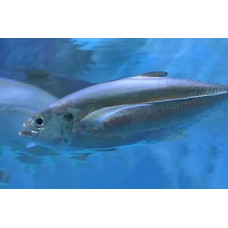Latin name
Megalaspis cordyla
Other name
Hardtail scad, finny scad, finletted mackerel scad, cordyla scad.
Identification
The body of these fishes is elongated, oval in shape, almost cylindrical in cross section, somewhat compressed from the sides in the posterior part. The caudal peduncle is short, strongly compressed at the sides, with a pronounced keel on both sides.
The snout and lower jaw are pointed. Eyes of moderate size with well defined fatty eyelids, almost completely covering the eye except for a vertical slit in the centre of the eye.
The lower and lateral parts of the thorax are bare, except for a triangular area of scales located one third of the way from the base of the pectoral fins. The first gill arch has 26-32 gill stamens, of which there are 8-11 gill stamens on the upper part and 18-22 stamens on the lower part.
The upper jaw has small tufted teeth, the outer teeth are enlarged. On the lower jaw the fine teeth are arranged in a single row. There are small teeth on the scutellum, palate and tongue.
The curved part of the lateral line has 21-28 scales; the straight part has 51-59 large bony flaps. There are 24 vertebrae, of which 10 are trunk vertebrae and 14 are tail vertebrae.
Features of fish fins
The first dorsal fin has 8 barb rays and the second has 1 barb ray and 18-20 soft rays. The third and fourth soft rays are elongated. Behind the second dorsal fin are 7-9 additional fins. The anal fin has 1 hard ray and 16-17 soft rays. In front of the anal fin are two separate barbels connected by a band. Behind the anal fin are 8-10 additional fins. The pectoral fins are long and strongly curved; their ends extend behind the beginning of the second dorsal fin. Caudal fin forked. The anterior part of the lateral line curves upwards. Passes into a straight part at the level of the vertical line between the fourth and fifth barb rays of the dorsal fin.
Fish colouring
The upper parts of the head and body of the torpedo scad are bluish-grey, the sides of the body and belly are silvery. There is a large black spot on the gill cover. The dorsal and anal fins are pale or yellow, with darker distal edges. The pectoral and ventral fins are pale with darker upper parts. The caudal fin is dark, especially the anterior and posterior margins.
Distribution
Widespread in the Indo-Pacific from South Africa and Madagascar, along the coast of East Africa to the Red Sea and Persian Gulf, and further east to India, Pakistan, Sri Lanka and Southeast Asia. In the western Pacific they are found from Japan to Australia and off the coasts of Palau, Samoa, New Caledonia, Tonga and the Marshall Islands.
Habitat
Pelagic marine fish. They prefer tropical climates and brackish water. They live on reefs at depths of 20-100 metres.
Size
Maximum body length is 80 cm, usually up to 45 cm; body mass is up to 4 kg. Fish reach a body length of 25 cm at age 1, 29 cm at age two, and 32 cm for three-year-old individuals. The maximum reported age of this species is 5 years.
Behavior
Adults usually live in schools in the sea.
Food and feeding habits
Torpedo scad feed mainly on fish.
Reproduction
On the southwest coast of India, females first mature at 24-25.9 cm, and 50% of the females in the population mature at 26.0-27.9 cm. Males are similar with 50% of males in the population maturing at 24-27.9 cm. They spawn once a year. The spawning season extends from December to June, with a peak in May-June. Female fecundity varies from 91854 to 324,292 eggs.
Fishing
Commercial fish. The main fisheries are off the coast of the central part of the Indo-Pacific region. Indonesia, Malaysia, the Philippines, Thailand and Indonesia catch most of the fish. It is caught using trawls, purse seines, longlines and demersal nets.
Relationship with a person
It is sold fresh, frozen, smoked, salted and dried. It is used for canning.
| Classification | |
| Phylum | Chordata |
| Class | Actinopterygii |
| Squad | Carangiformes |
| Family | Carangidae |
| Genus | Megalaspis |
| Species | M. cordyla |
| Features | |
| Conservation status | Least Concern |
| Habitat | Pelagic |
| Life span, years | 5 |
| Maximum body weight, kg | 4 |
| Maximum length, cm | 80 |
| Sailing speed, m/s | No information |
| Threat to people | Edible |
| Way of eating | Predator |
Torpedo scad
Tags: torpedo scad


